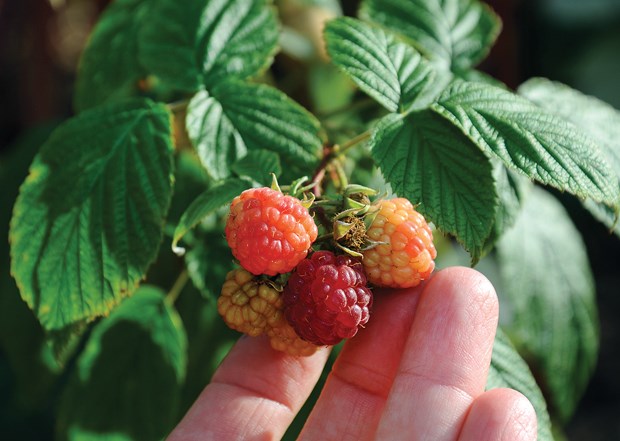Take a walk through the community garden at Queen Mary elementary and you may see something you didn’t expect: fruit trees.
Pears, cherries, apples, and plums, are all part of the “food forest,” as staff at the Edible Garden Project refer to it.
The trees are only about five years old, so they haven’t reached their full production yet. But they still managed to yield an impressive crop this year, although most of the fruit is now gone, free for members of the public to pick. A lot of people think about the Okanagan when they think about growing fruit, but part of the reason the EGP grew these trees, some berry bushes, and a herb garden, was to show North Shore residents it can be done here too.
EGP manager Emily Jubenvill explains that the purpose of all their community gardens, and in the food forest in particular, is to demonstrate how much food can be grown from perennial systems.
“Most people when they think of edible food they think about annual vegetables, but there’s lots of stuff that you can plant once and it will produce for decades,” she notes.
It’s all part of a bigger focus to engage community members in the art of gardening, and it was a desire to involve the community that changed the group’s initial approach to the garden.
The garden has individual plots of raised beds that are rented out to community members, who typically grow vegetables or flowers. Around some of the borders and in between the two sides there’s more of a communal area, which the Edible Garden Project has been involved in over the past number of years (their “food forest”).
When the community garden was being designed there was a public walkway right through the middle of it that the community wanted to keep, so the garden was built around it in two halves, one on either side of the walkway. Over the years, the EGP focused on building the soil because it was really shallow and rocky. They used a lot of mulch, compost, and leaves to enrich the soil.
“But it just takes time really,” explains Jubenvill. “Now we have amazing soil, which is fantastic.”
The decision to allow the public to pick the food from the EGP area of the garden was based on a “nest of factors,” says Jubenvill, but one of the main reasons was stealing. Food grown in the rented plots is meant for the gardeners who grow it. But some people take the food and that upsets the gardeners. “They put lots of time and energy into them typically,” says Jubenvill.
When the garden first started the food forest was being planted for workshops and demonstrations and for the food to be donated. But over the years it became apparent there was stealing still happening all over the garden despite signs asking people not to take the food. So the gardeners suggested inviting people into a specific area in the garden to pick from.
The plan worked and the EGP’s food forest became free to the public. Besides cutting down on stealing from the rented plots, Jubenvill says the move also helped build relationships with more people in the community that aren’t necessarily gardeners.
“It’s a nice way for people just walking by to also get to interact with the garden regardless of whether or not they have a plot there,” she notes. And EGP is still able to donate food to various organizations, including the Food Hub at North Shore Neighbourhood House, through its other North Shore gardens, such as Loutet Farm.
As of mid-October, most of the fruit, berries, and herbs have been taken and that’s OK.
“If people are using it that’s the point,” says Jubenvill.



